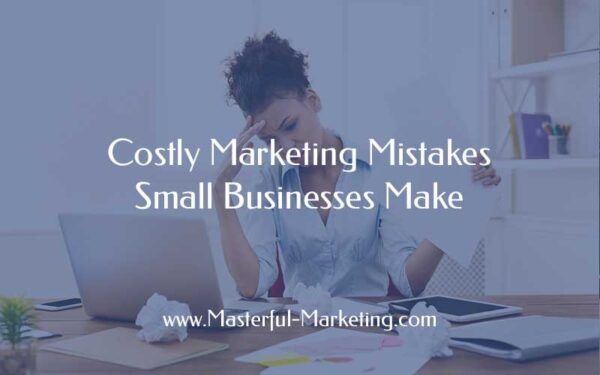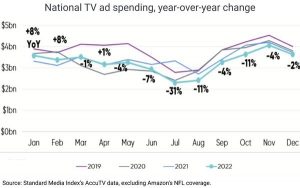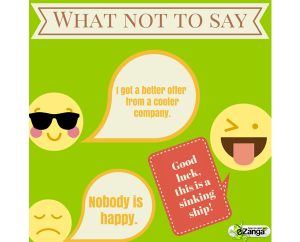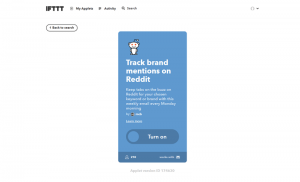
Marketing is an investment in your business. Creating and implementing an inbound marketing plan can increase your visibility and strengthen your expert reputation. But marketing mistakes can be costly to your small businesses in terms of dollars, reputation, visibility and results. They can lead to customers questioning your expertise and move on to evaluating your competitor.
Successful marketing efforts take a combination of planning, creativity and patience. As you review your plan and adjust for the next 90 days, make sure you are not making these costly marketing mistakes.
Strategic marketing mistakes
1. Not defining your target audience and understanding their needs
Trying to be everything to everybody means you dilute your message and attract no one. People want to do business with someone who understands them. They want someone who can provide clarity and help to achieve their goals. By focusing on one specific market, you can clearly identify why they should do business with you.
Once you have chosen your starter market, define the characteristics of your ideal client.
- What do they desperately need that you can help with?
- Do you understand their challenges?
- Can you clearly describe how you can help them better than anyone else?
The more you know about your customers, the more effective your marketing efforts will be. Study your best customers and why they chose your business. Get to know your ideal client intimately so you can produce the results they are looking for.
2. Not developing a marketing plan or 90 day action plan
Jumping right into activities without understanding what strategies can help you achieve your goals, sets you up for inefficient marketing with little to no results. Not establishing a solid plan before taking on any activities results in ineffective programs that waste your budget.
The value of developing a plan is to set the direction of your marketing so you can keep moving towards your goals. Once you decide on your strategy, you need to stay focused on executing that strategy. Constant change to compete with the latest fad does not breed success.
Once you have your strategy, create a 90 day action plan that provides constant feedback loops. This feedback indicates whether things are working or not. Break your 90 days into 6 to 7 two week sprints where you can narrow down what you need to work on now. These two week sprints enable you to quickly measure what is working or not, enabling you to adjust your efforts before its too late.
Costly marketing mistakes that a sprint eliminates includes:
- Sticking with an ineffective strategy – The definition of insanity is doing the same thing over and over and expecting different results. Don’t get complacent and think that “things will get better” if you are not getting the results you want with your current activities. Review what is happening at least quarterly and adjust as needed.
- Changing a strategy that works – On the other hand, if you have a marketing strategy that consistently gives results and gets you closer to your overall outcome goal, then why change it? Enhance, extend and improve your strategy to keep it fresh and effective, but don’t make radical changes to something that is working.
- Stopping an Activity Too Soon – Easily the most costly mistake is changing your marketing messages or brand midstream. Just about the time you are sick of your marketing, your prospects are just beginning to recognize who you are. Marketing requires patience so give your marketing time to work.
3. Not creating a powerful web presence
All businesses should develop and maintain an extensive digital footprint. The bigger the footprint, the more likely your business can be found when someone is searching.
Your digital footprint is everything that can be found about your business online. It is made up of your:
- Website
- Social media profiles
- Directory listings
Some of these you create, others are created for you. All of them should be consistent in their brand and messages to avoid confusion. Consistency with your message and brand across all of your online properties helps to drive home your value.
Your website is the hub of your online presence. Make sure it:
- Is professionally designed in WordPress
- Works perfectly on a mobile device
- Has an SSL certificate installed
- Optimized for visibility.
Prospects want to know how working with you is going to help them. They need to see the value you offer and quickly realize the potential benefits of working with you. Keep the details about how wonderful your company is as background information. People need to trust that your business can help them.
Create social media profiles only for those platforms that make sense for your business. You don’t, and shouldn’t, be everywhere. Focus on those that can reach your audience most effectively. Then use these platforms to get your prospect’s attention and drive them to your website or to sign up for your email list.
4. Not investing in marketing when the economy is bad
Marketing keeps you visible when the market is slow. It helps you stay top of mind with your prospects. Staying active lets your prospects know that you are alive and well.
Cutting marketing is a big mistake in tough economic times. Reducing spending and ensuring your marketing dollar is spent wisely is important. Look at your plan and do the things that are low cost or free to get you through the downturn. But stopping marketing completely requires you to start all over once the economy turns or your pipeline is empty.
Now avoid these 6 marketing tactical mistakes
1. Not paying attention to details

How people perceive your business is based on what image you regularly project. Whether it is online or off, not reviewing your marketing materials for typos, grammatical errors or other issues can detract from your message. It hurts your professional image and can send a negative message.
If you don’t care to project the best image for your business, what makes a potential client think you will deliver above and beyond when providing services to them? Always have another pair of eyes look at your materials before you publish, both online and in print.
2. Deviating from your brand
Your brand is the promise you make to your customers. It is the perception the world has of your business and communicates your personality and values. It also highly influences your prospects’ opinion of who you are and whether they want to do business with you.
Customers know immediately when there is a disconnect between what you have promised and what they receive. If your marketing activities deviate from the voice and reputation your brand has already established, you run the risk of confusing, disappointing or angering your customers and prospects. Ensure that all of your marketing stays true to your message and the promise of your brand.
3. Not adhering to email marketing best practices
Nothing is more frustrating than receiving an email newsletter I didn’t sign up for. People are adding their LinkedIn connections to their email lists. Don’t do that! Connecting doesn’t give you permission to add someone to your list. In fact, it can damage your brand reputation.
One of the most powerful resources for marketing your business is your in-house email list full of prospects that are interested in what you offer.
- Use a reputable email service provider (MailChimp, Constant Contact, aWeber, etc) to build your list.
- Write interesting emails that grab their attention.
- Be sure your email is easily read on a mobile device.
- Figure out the best cadence for your emails (i.e. frequency and timing)
Then use email marketing to keep in touch with your prospects and customers. Create offers that take them from being an interested party to a paying customer.
4. Not seeking professional help to create your brand identity
I’m all for small business owners being in control of their marketing efforts. However, when it comes to laying the foundation for a consistent online brand, you may want to think twice about creating your own brand, website or social media strategy without professional help.
It is far more cost-effective to create your brand identity right the first time. Hire professionals for those areas that require a unique skill – design, development and user experience. Then you can begin promoting your business with confidence, knowing your brand projects all that is good in your business.
5. Neglecting your online presence
Now that you’ve spent time creating a powerful web presence, don’t forget to review it regularly. You need to know what has been written about your business across the various review sites. Once someone searches for your business, what they see will determine whether they contact you or your competition.
No business will ever please 100% of their customers. Unfortunately, when someone is unhappy, they are more likely to go online and write a bad review. Make sure you respond to that review. Ask your happy customers to contribute a good review. Provide them links to your preferred review pages. Get a few on Google, Yelp, Better Business Bureau and any industry specific review site.
The biggest marketing mistake of all: believing that marketing is an expense, not an investment
If you have the mindset that everything you do in marketing is an expense, ready to cut when things aren’t working just right, then you are setting your business up to fail. Marketing is a process that requires a regular, consistent investment to increase your visibility and demonstrate your expertise. If you stop marketing to cut costs, your marketing efforts, and ultimately your business, will fail.
Spending time on marketing while trying to manage other aspects of your business has its challenges. By implementing your 90 day marketing action plan, you can avoid making these costly mistakes. Your business will be more successful if you do.
Business & Finance Articles on Business 2 Community
(61)
Report Post





